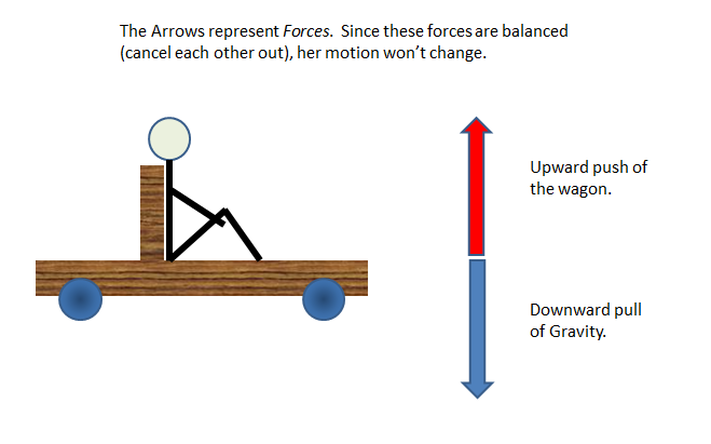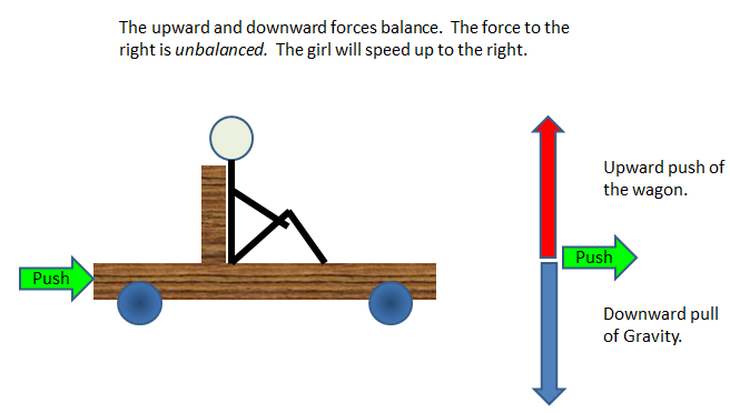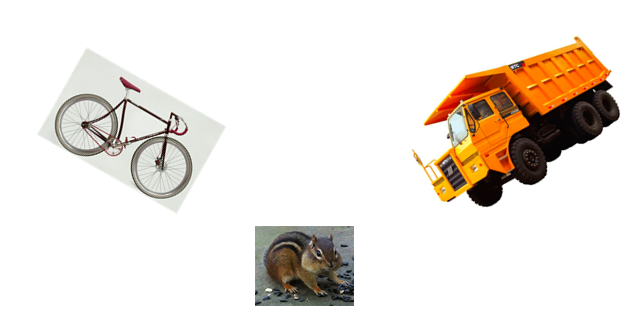2.1 - What causes objects to move?

This is a question that mankind has pondered for centuries. The Ancient Greeks were most certainly not the first people to ponder this question but, thanks to Aristotle (we’ve met him already), they developed and recorded a system that explained so much about the motion of objects that it was accepted by scholars for two thousand years.
Aristotle developed a Natural Place Theory of motion. Back then the Universe was thought to be comprised of four elements: Earth, Water, Air, and Fire. Earth’s position was at the center; Water was above Earth; Air was above Water; and Fire was above Air. Any element found out of its natural place would return to its place as soon as possible.
Aristotle developed a Natural Place Theory of motion. Back then the Universe was thought to be comprised of four elements: Earth, Water, Air, and Fire. Earth’s position was at the center; Water was above Earth; Air was above Water; and Fire was above Air. Any element found out of its natural place would return to its place as soon as possible.
Examples: A stone held out of its natural place (in the Air, above the Earth) gives evidence of wanting to return to its place by pressing downward. The stone will fall downward when released. Raindrops fall downward through the air, air bubbles move upward through water, flames from a fire move upward through air, etc. Superficially, the Natural Place Theory explained a lot.
Aristotle further deduced that the more Earth an object has, the more eager it is to return to its natural place. The heavier the object, the greater its “eagerness”, the quicker it would fall. Again, slowly falling leaves and feathers versus quickly falling stones and arrows provided visual evidence to support this theory.
Finally, once an object returned to its natural place, it would return to a state of rest. Aristotle theorized that the natural state for an object was to be at rest. Violent motion (away from the natural place) would eventually yield to natural motion (towards the natural place) and, once back at the natural place, it would stop moving. Examples of this in everyday life abound. A driven golf ball, even if a pro golfer does the driving, eventually comes to a stop.
Aristotle further deduced that the more Earth an object has, the more eager it is to return to its natural place. The heavier the object, the greater its “eagerness”, the quicker it would fall. Again, slowly falling leaves and feathers versus quickly falling stones and arrows provided visual evidence to support this theory.
Finally, once an object returned to its natural place, it would return to a state of rest. Aristotle theorized that the natural state for an object was to be at rest. Violent motion (away from the natural place) would eventually yield to natural motion (towards the natural place) and, once back at the natural place, it would stop moving. Examples of this in everyday life abound. A driven golf ball, even if a pro golfer does the driving, eventually comes to a stop.

Remember our little experiment from Chapter One? Hold a piece of paper level to the ground and drop it. Observe how much time it takes to reach the ground. Now, crumble up the same piece of paper and drop it again. Obviously, it falls faster crumbled up. The amount of Earth in the paper didn’t change so why was the crumbled paper more eager to reach its natural place?
That little experiment certainly puts a dent in the Natural Place Theory. It seems difficult to believe that this important theory received essentially no testing over two thousand years, but it is true. The ancient Greeks were Philosophers and definitely favored deduction through assumptions and reasoning rather than experimentation. In fact, scholars in general did not recognize or appreciate the value of experimentation as a method of testing hypotheses until the 16th century.
That little experiment certainly puts a dent in the Natural Place Theory. It seems difficult to believe that this important theory received essentially no testing over two thousand years, but it is true. The ancient Greeks were Philosophers and definitely favored deduction through assumptions and reasoning rather than experimentation. In fact, scholars in general did not recognize or appreciate the value of experimentation as a method of testing hypotheses until the 16th century.
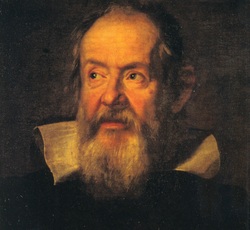 Galileo Galilei
1564-1642
Galileo Galilei
1564-1642
Galileo
At the turn of the 16th century, Galileo Galilei (we've met him before too) was studying the motion of objects. He was a very precise and observant scientist. He tried to find the simplest explanations for what he observed and would then test his explanation under various conditions to see if they held true. As we have said earlier in this book, it was Galileo who first began using a systematic approach to testing his hypotheses.
At the turn of the 16th century, Galileo Galilei (we've met him before too) was studying the motion of objects. He was a very precise and observant scientist. He tried to find the simplest explanations for what he observed and would then test his explanation under various conditions to see if they held true. As we have said earlier in this book, it was Galileo who first began using a systematic approach to testing his hypotheses.
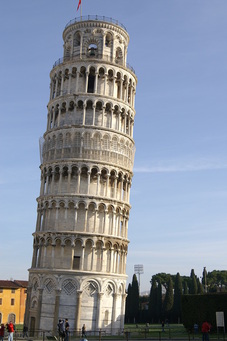
One of the many phenomena that fascinated Galileo was the behavior of falling objects. You have probably heard or read a story about Galileo dropping objects of different sizes off the Leaning Tower of Pisa. This story is almost certainly a myth but it does celebrate Galileo’s zeal and ingenuity as a scientist. What he actually did, in much less spectacular fashion, was to set up a couple of ramps to study the motion of a marble. The was no such thing as a stop watch in the 16th century and a free fall from any reasonable height was completed much too quickly so Galileo used the ramps to slow the process down.
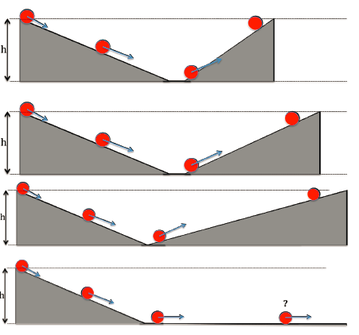 Galileo's Ramps
Galileo's Ramps
He would allow the marble to roll down one ramp and then up the other, measuring the time it took to fall and rise as well as the heights at which the marble started and stopped. The up part of the ramp could also have its angle changed.
When Galileo released the marble from a height, h, it would roll down the ramp and back up, and almost go to h again. When he changed the slope of the up ramp, the marble still almost made it to the height h! No matter what the angle, the marble would roll almost back to its original height. Galileo then asked, “What would happen if the marble were never given the chance to get back to its original height?” His answer was simple. It would go on forever at the same speed. That is, if there were no friction, Galileo said that the nature of a moving object was not to come to rest but to continue its motion. The tendency of an object to continue its motion is defined as Inertia.
Galileo also used the ramp experiments to study the rate at which objects fell. With repetition and careful measurement, Galileo proved that (again, in the absence of friction), heavy objects fall at the same rate as lighter objects.
With these simple yet dramatic experiments, Galileo initiated the downfall of Aristotle’s view of the universe.
When Galileo released the marble from a height, h, it would roll down the ramp and back up, and almost go to h again. When he changed the slope of the up ramp, the marble still almost made it to the height h! No matter what the angle, the marble would roll almost back to its original height. Galileo then asked, “What would happen if the marble were never given the chance to get back to its original height?” His answer was simple. It would go on forever at the same speed. That is, if there were no friction, Galileo said that the nature of a moving object was not to come to rest but to continue its motion. The tendency of an object to continue its motion is defined as Inertia.
Galileo also used the ramp experiments to study the rate at which objects fell. With repetition and careful measurement, Galileo proved that (again, in the absence of friction), heavy objects fall at the same rate as lighter objects.
With these simple yet dramatic experiments, Galileo initiated the downfall of Aristotle’s view of the universe.
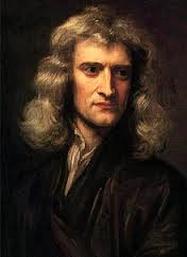 Isaac Newton 1642-1727
Isaac Newton 1642-1727
Sir Isaac Newton
In one of the great ironies of science, Sir Isaac Newton was born in 1642 – the same year that Galileo died. Newton is commonly recognized as one of history’s greatest scientists. Among his many achievements, Newton developed three Laws of Motion and published these in 1687 in a landmark treatise called Principia Mathematica.
Newton’s First Law of Motion is a restatement of Galileo’s idea:
An object in motion (or at rest) will remain in motion along a straight line (or at rest), unless acted upon by an outside, unbalanced force.
This is usually referred to as the Law of Inertia.
What this means is that on object will continue to do what it is doing until it is pushed or pulled (outside force) by something else. If the forces on it cancel each other out, then the motion will not change.
In one of the great ironies of science, Sir Isaac Newton was born in 1642 – the same year that Galileo died. Newton is commonly recognized as one of history’s greatest scientists. Among his many achievements, Newton developed three Laws of Motion and published these in 1687 in a landmark treatise called Principia Mathematica.
Newton’s First Law of Motion is a restatement of Galileo’s idea:
An object in motion (or at rest) will remain in motion along a straight line (or at rest), unless acted upon by an outside, unbalanced force.
This is usually referred to as the Law of Inertia.
What this means is that on object will continue to do what it is doing until it is pushed or pulled (outside force) by something else. If the forces on it cancel each other out, then the motion will not change.
Picture a person sitting in a wagon. If she is at rest then the forces on her must be balanced. One force on her is the gravitational force between her and the earth (her weight). The other force is the floor of the wagon pushing up on her.
If someone were to give the wagon a push- that would be an outside force and her motion would change. She would speed up or accelerate.
The net force is the sum of all the forces on an object. It is symbolized with the Greek letter sigma (Σ). When ΣF = 0, there is no change in motion, no acceleration. If the net force is not zero, there is a change in motion- an acceleration. An object’s motion can change (accelerate) in three ways. It can speed up, slow down, or turn.
Inertia can also be described as how easy or difficult it is to change the motion of an object. Mass is the measure of an object’s inertia. It can also be described as how much matter an object is. A massive object will require a greater net force to change its motion than a less massive object.
Think of it this way.
A 10 Kg bicycle is rolling down a hill. You are at the bottom of the hill and see it heading straight for a little chipmunk in the road. This chipmunk is particularly adorable. Bravely, you jump into the road and stop the bike before it hurts anyone and anything.
What if the story was changed by just one thing? Instead of a 10 kg bicycle, it is a 10,000 Kg truck. It is going just as fast when it gets to the bottom of the hill, but would you dare jump in front of it to stop it? Most definitely not! To change the truck’s motion would require much too much a force from you. It would change your motion more than you could change its motion.
Inertia can also be described as how easy or difficult it is to change the motion of an object. Mass is the measure of an object’s inertia. It can also be described as how much matter an object is. A massive object will require a greater net force to change its motion than a less massive object.
Think of it this way.
A 10 Kg bicycle is rolling down a hill. You are at the bottom of the hill and see it heading straight for a little chipmunk in the road. This chipmunk is particularly adorable. Bravely, you jump into the road and stop the bike before it hurts anyone and anything.
What if the story was changed by just one thing? Instead of a 10 kg bicycle, it is a 10,000 Kg truck. It is going just as fast when it gets to the bottom of the hill, but would you dare jump in front of it to stop it? Most definitely not! To change the truck’s motion would require much too much a force from you. It would change your motion more than you could change its motion.
